DJI
SZ DJI Technology Co., Ltd.[3] or Shenzhen DJI Sciences and Technologies Ltd. (Chinese: 深圳大疆创新科技有限公司) in full,[4] more popularly known as its trade name DJI, which stands for Da-Jiang Innovations (大疆创新; 'Great Frontier Innovations'), is a Chinese technology company headquartered in Shenzhen, Guangdong with manufacturing facilities throughout the world. DJI manufactures commercial unmanned aerial vehicles (drones) for aerial photography and videography. It also designs and manufactures camera gimbals, action cameras, camera stabilizers, flight platforms and propulsion systems and flight control systems.
 | |
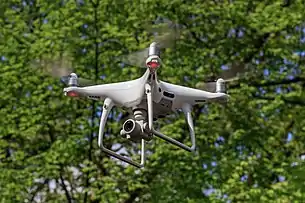 | |
| DJI | |
Native name | 大疆创新科技有限公司 |
| Type | Private |
| Industry | |
| Founded | 2006 |
| Founder | Frank Wang (Wang Tao) |
| Headquarters | , |
Area served | Worldwide |
| Products | |
| Revenue | |
Number of employees | 14,000[2] (2018) |
| Divisions |
|
| Subsidiaries | Hasselblad |
| Website | www |
DJI accounts for around 1% of the world's consumer drone market as of March 2020,[5] with no other company accounting for more than 5%.[6][7] Its camera drone technology is widely used in the music, television and film industries. The company's products have also been used by militaries and police forces,[8] as well as terrorist groups, with the company taking steps to limit access to the latter.[9] US government institutions have issued statements discouraging their internal use of DJI products,[10] but as of 2020, various agencies at the local and federal level continue to use DJI products.[8]
History
The company was founded in 2006 by Frank Wang (Wang Tao, 汪滔).[11] Born in Hangzhou, Zhejiang, he enrolled in the Hong Kong University of Science and Technology (HKUST) for college in 2003. He was part of the HKUST team participating in ABU Robocon and won third prize.[12]
Wang built the first prototypes of DJI's projects in his dorm room, selling the flight control components to universities and Chinese electric companies. He used the proceeds to move to the industrial hub of Shenzhen and hired a small number of staff in 2006. The company struggled at first, with a high degree of churn among employees that has been attributed to Wang's abrasive personality and perfectionist expectations of his employees. The company sold a modest amount of components during this period, relying as well on financial support from Wang's family friend, Lu Di, who provided US$90,000 and managed the company's finances.[13] In 2009, DJI's components allowed a team to successfully pilot a drone around the peak of Mt. Everest.[8]
In 2010, Wang hired a high school friend, Swift Xie Jia, to run the company's marketing. DJI began to cater more to drone hobbyists in markets outside of China. In 2011, Wang met Colin Guinn at a trade show, and the two of them founded DJI North America, a subsidiary company focusing on mass market drone sales. In 2013, DJI released the first model of the Phantom drone, an entry-level drone which was more user-friendly than other drones on the market at the time.
The Phantom was commercially successful, but it led to conflict between Guinn and Wang. Midway through the year, Wang made an offer to buy Guinn out, which Guinn refused. By the end of the year, DJI had locked all employees of the North American subsidiary out of their email accounts and was well on its way to shutting down the subsidiary's operations. Guinn sued DJI, with the case being settled out of court.[13]
In 2015, DJI eclipsed the success of the Phantom with the release of the Phantom 3, whose even greater popularity was in part due to the addition of a built in live-streaming camera.[8] DJI was now the largest consumer drone company in the world,[14] driving many of its competitors out of the market over the following years.[8] 2015 also marked the beginning of DJI's RoboMaster Robotics Competition (机甲大师赛), an annual international collegiate robot combat tournament held at the Shenzhen Bay Sports Centre.[15]
In 2017, DJI won a Technology & Engineering Emmy Award for its camera drone technology, which was used in the filming of various television shows including The Amazing Race, American Ninja Warrior, Better Call Saul and Game of Thrones.[16] That same year, Wang became Asia's youngest tech billionaire,[17] and world's very first drone billionaire.[18]
Also in 2017, signed a strategic cooperation agreement to provide surveillance drones for use by the Chinese police in Xinjiang.[8][19]
On 5 June 2018, police body cam and Taser maker Axon announced a partnership with DJI to sell surveillance drones to U.S. police departments.[20][21] As of 2020, DJI products are also widely used by U.S. police and fire departments.[8]
On 21 January 2019, DJI announced that an internal probe had uncovered "extensive" fraud by certain employees who "inflated the costs of parts and materials for certain products for personal financial gain."[22] DJI estimated the cost of the fraud at "up to CN¥1 billion" (US$147 million), but maintained that the company "did not incur a full year loss in 2018."[23]
In January 2020, the United States Department of the Interior announced that it would be grounding around 800 drones, which it had been using for wildlife conservation and infrastructure monitoring purposes. As of March 2020, DJI holds nearly 77% of the US market share for consumer drones, with no other company holding more than 4%.[8]
In 2020, DJI drones are being used by many countries around the world to combat the corona virus.[24] In China, DJI drones are used by the police force to remind people to wear masks. In other countries, such as Morocco and Saudi Arabia, DJI drones are used to disinfect urban areas and monitor human temperatures in order to contain the spread of coronavirus.[25]
Corporation structure and infrastructure
In 2018, DJI raised roughly $1 billion in funds in preparation for an envisioned IPO at the Hong Kong Stock Exchange.[26] As of July 2020, these rumors persisted with no indication that an IPO is forthcoming.[27] The company had previously raised $500 million in a 2015 funding round from investors including New China Life Insurance Co Ltd, GIC, and New Horizon Capital, the latter being co-founded by the son of China's former premier minister Wen Jiabao.[28]
DJI counts roughly 14,000 employees and has 17 offices internationally.[29] The company is known for having a very difficult hiring process, as well as an extremely competitive internal culture, where teams are often pitted against each other to design better products.[8]
DJI's factories in Shenzhen include highly sophisticated automated assembly lines. Many of the components for these assembly lines are built in-house.[8]
Products
Controllers
DJI develops flight controllers intended for multi-rotor stabilization control of various platforms or heavy payloads in aerial photography. The A2 controller includes orientation, landing, and home return features. Products include GPS-compass receivers, LED indicators and Bluetooth connectivity.[30][31]
| Model | A2 | Naza V2 | Wookong-M | Naza-M Lite |
|---|---|---|---|---|
| Number of motors supported | 4–8 | 4–8 | 4–8 | 4–6 |
| Has built-in receiver | yes (2.4 GHz) | no | no | no |
| Hovering accuracy (m) | vertical: ±0.5m / horizontal: ±1.5m | vertical: ±0.8m / horizontal: ±2.5m | vertical: ±0.5m / horizontal: ±2m | vertical: ±0.8m / horizontal: ±2.5m |
| Motor-rotor configuration | quad-rotor: +4,X4; hex-rotor: +6,X6,Y6,Rev Y6; octo-rotor: +8,X8,V8 | quad-rotor: I4, X4; hex-rotor: I6, X6, IY6, Y6; octo-rotor: I8,V8,X8 | quad-rotor: +4,X4; hex-rotor: +6,X6,Y6,Rev Y6; octo-rotor: +8,X8,V8 | quad-rotor I4, X4; hex-rotor I6, X6, IY6, Y6 |
Ronin
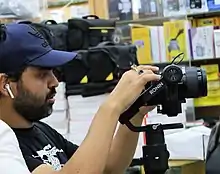
The Ronin (如影) is a standalone ground-based camera platform developed for cinematography and aerial filmmaking in professional environments. It is built for professional videography and photography and targets the film industry. By using three individual motors, Ronin stabilizes when moving vigorously.[32] Later models of the Ronin include the Ronin-M, Ronin 2, Ronin-S, and Ronin-SC.[33][34]
Modules
| Module | Lightbridge | PMU (A2, Wookong, Naza V2, Naza Lite) | iOSD MARK II | iOSD mini | BTU |
|---|---|---|---|---|---|
| Type (Purpose) | Video Downlink | Power Management | On-Screen Display | On-Screen Display | Bluetooth Link |
| Works With | A2, Wookong-M, Naza V2 | A2, Wookong-M, Naza V2, Naza-M Lite | A2, Wookong-M, Naza V2 | A2, Wookong-M, Naza V2 | Naza V2 |
| Interface | CAN Bus | CAN Bus, Battery Connection | CAN Bus | CAN Bus | CAN Bus |
| Battery Requirements | 4S-6S Lipo | 4S-12S Lipo | 4S Lipo and Shared Flight Controller Power | 2S Lipo and Shared Flight Controller Power | Shared Flight Controller Power |
Flame Wheel
The Flame Wheel (风火轮) series are multirotor platforms for aerial photography. As of 2016, there is the hexacopter F550, and quadcopters F330 and F450. The most recent is the ARF KIT.[35][36]
| Model | Flame Wheel F330 | Flame Wheel F450 | Flame Wheel F550 |
|---|---|---|---|
| Diagonal wheelbase (cm) | 33 | 45 | 69 |
| Frame weight (g) | 156 | 282 | 478 |
| Take-off weight (g) | 600–1200 | 800–1600 | 1200–2400 |
Phantom
.jpg.webp)
The Phantom (精灵) series has evolved to integrated flight programming with a camera, Wi-Fi or Lightbridge connectivity, and the pilot's mobile device.[37] Phantoms are made for aerial cinematography and photography applications,[38] but are also used in recreational use.[39]
There have now been four generations of the product line, the most recent one is the Phantom 4 RTK, announced on October 15, 2018.[40][41][42]
| Model | Phantom 1 | Phantom 2 | Phantom 2 Vision | Phantom 2 Vision+ | Phantom FC40 | Phantom 3 Standard | Phantom 3 4K | Phantom 3 Advanced | Phantom 3 Professional | Phantom 3 SE | Phantom 4 | Phantom 4 Pro | Phantom 4 Advanced | Phantom 4 Pro v2.0 |
|---|---|---|---|---|---|---|---|---|---|---|---|---|---|---|
| Diagonal wheelbase (mm) | 350 | 350 | 350 | 350 | 350 | 350 | 350 | 350 | 350 | 350 | 350 | 350 | 350 | 350 |
| Height (m) | 0.19 | 0.19 | 0.19 | 0.19 | 0.19 | 0.19 | 0.19 | 0.19 | 0.19 | 0.19 | 0.19 | 0.19 | 0.19 | 0.19 |
| Power consumption (W) | 3.12 | — | — | — | 3.12 | — | — | — | — | — | — | — | — | — |
| Take-off weight (g) | < 1200 | < 1300 | 1180 | 1284 | 1200 | 1216 | 1280 | 1280 | 1280 | 1280 | 1380 | 1388 | 1368 | 1375 |
| Max speed (m/s) | 10 | 15 | 15 | 15 | 10 | 16 | 16 | 16 | 16 | 16 | 20 | 20 | 20 | 20 |
| Endurance (min) | — | 25 | 25 | 25 | 10 | 25 | 25 | 23 | 23 | 25 | 28 | 30 | 30 | 30 |
| Rate of climb/descend (m/s) | 6 | 6/2 | 6/2 | 6/2 | 6 | 5/3 | 5/3 | 5/3 | 5/3 | 5/3 | 6/4 | 6/4 | 6/4 | 6/4 |
| Operating temperature (°C) | −10 to 50 | −10 to 50 | — | — | −10 to 50 | 0 to 40 | 0 to 40 | 0 to 40 | 0 to 40 | 0 to 40 | 0 to 40 | 0 to 40 | 0 to 40 | 0 to 40 |
| Maximum altitude (m) | 6000 | 6000 | 6000 | 6000 | 6000 | 6000 | 6000 | 6000 | 6000 | |||||
| Maximum range (m) | 1000 | 4000 | 5000 | 7000 | 7000 | 7000 |
Mavic
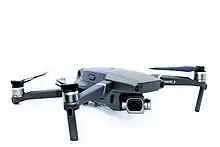
The Mavic (御) series currently includes Mavic Pro, Mavic Pro Platinum, Mavic Air, Mavic Air 2, Mavic 2 Pro, Mavic 2 Zoom, and the Mavic Mini. The release of the Mavic Air 2 was not without controversy, however, as DJI announced that a key safety feature, AirSense (ADS-B), would not be available on models outside the USA.[43] Shortages on components and complexities of production owing to the ongoing COVID-19 crisis at the time were blamed.
| Model | Mavic Pro | Mavic Air | Mavic 2 Pro | Mavic 2 Zoom | Mavic Mini | Mavic Air 2 |
|---|---|---|---|---|---|---|
| Maximum Speed (Sport mode, no wind) | 40 MPH / 65 km/h / 18.0 m/s | 42.5 MPH / 68.4 km/h / 19.0 m/s | 45 MPH / 72 km/h / 20 m/s | 45 MPH / 72 km/h / 20 m/s | 29 MPH/ 46.8 km/h / 13 m/s | 42.5 MPH/ 68.4 km/h / 19 m/s |
| Maximum Speed (P-Mode) | 22 MPH / 35 km/h / 9.7 m/s | 15.5 MPH / 25 km/h / 6.9 m/s | 30 MPH / 48 km/h / 13.4 m/s | 30 MPH / 48 km/h / 13.4 m/s | 17.9 MPH / 28.8 km/h / 8 m/s | 26.84 MPH / 43.2 km/h / 12 m/s |
| Maximum Speed (WiFi only mode) | 8.7 MPH / 14 km/h / 3.9 m/s | -- | -- | -- | 8.9 MPH / 14.4 km/h / 4 m/s | |
| Empty weight (grams) | 734 (without gimbal cover) / 743 (with gimbal cover) | 430 (without gimbal cover) | 907 (max takeoff weight) | 905 (max takeoff weight) | 249 (default) / 199 (Japan) | 570 (max takeoff weight) |
| Flight time | ~27 Mins | ~21 Mins | ~31 Mins | ~31 Mins | ~30 Mins | ~34 Mins |
| Realistic flight time | ~21 Mins | ~16 Mins | ~29 Mins | ~29 Mins | ~27 Mins | ~27 Mins |
| Operating temperature (°C) | 32° to 104 °F (0° to 40 °C) | 32° to 104 °F (0° to 40 °C) | 14° to 104 °F (-10° to 40 °C) | 14° to 104 °F (-10° to 40 °C) | 32° to 104 °F (0° to 40 °C) | 14° to 104 °F (-10° to 40 °C) |
| Range (with controller) | 4.3 miles / 7 km, 2.2 miles / 3.5 km with CE controller. | 4 kilometers, 2 kilometers with CE controller | 5 miles / 8 km | 5 miles / 8 km | 4 kilometers, 2 kilometers with CE controller | 10 kilometers, 6 kilometers with CE controller |
| Range (with WiFi only) | 262 feet/ 80 meters | -- | -- | -- | -- |

Spreading Wings

The Spreading Wings (筋斗云) series are mainly industrial UAVs for professional aerial photography, high definition 3D mapping, ultra-light search and rescue, and surveillance etc. based on camera gear on board. In 2013, two models were released: S800 regular and EVO.[44]
| Model | Spreading Wings S800 | Spreading Wings S800 EVO | Spreading Wings S900 | Spreading Wings S1000 |
|---|---|---|---|---|
| Diagonal wheelbase (cm) | 80 | 80 | 90 | 104.5 |
| Empty weight (kg) | 2.6 | 3.7 | 3.3 | 4.2 |
| Take-off weight (kg) | 5 – 7 | 6 – 8 | 4.7 – 8.2 | 6 – 11 |
| Endurance (min) | 16 | 20 | 18 | 15 |
| Operating temperature (°C) | — | — | - 10 to 40 | - 10 to 40 |
Inspire
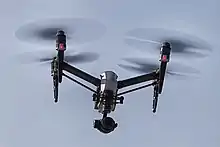
The Inspire (悟) series is a professional series of camera quadcopters similar to the Phantom line, but with an aluminum-magnesium body with carbon fibre arms, as well as detachable props on the Inspire 2. It was presented in 2017.[45]
Inspire specifications:[46]
| Model | Inspire 1 | Inspire 1 Pro | Inspire 2[47] |
|---|---|---|---|
| Weight | 2935 g (Battery included) | 3400 g (Battery, propellers and Zenmuse X5 included) | 3440 g (Battery, propellers and camera on board) |
| Takeoff weight | 3400 g | 3500 g | 4000 g |
| Hovering accuracy
GPS mode |
vertical: 0.5 m; horizontal: 2.5 m | vertical: 0.5 m; horizontal: 2.5 m | vertical: 0.5 m; horizontal: 1.5 m |
| Max angular velocity | pitch: 300°/s; yaw: 150°/s | pitch: 300°/s; yaw: 150°/s | pitch: 300°/s; yaw: 150°/s |
| Max tilt angle | 35° | 35° | 35° |
| Max ascent/descent speed | 5/4 m/s | 5/4 m/s | 5/6 m/s |
| Max speed | 22 m/s (ATTI mode, no wind) | 18 m/s (ATTI mode, no wind) | 24 m/s (ATTI mode, no wind) |
| Max flight altitude | 4500 m | 4500 m | 4500 m |
| Max wind speed resistance | 10 m/s | 10 m/s | 10 m/s |
| Operating temperature range | −10°−40 °C | −10°−40 °C | −20°−40 °C |
| Max flight time | approximately 18 minutes | approximately 15 minutes | approximately 27 minutes |
| Indoor hovering | Enabled by default | Enabled by default | Enabled by default |
| Release date | November 13, 2014 | January 5, 2016 | November 16, 2016 |
Matrice
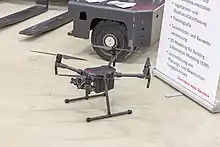
The Matrice (经纬) series is designed for industrial applications, including surveying, inspection, search and rescue and firefighting.[48]
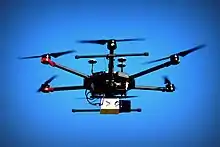
The Matrice 100 is a fully programmable and customizable drone, launched on July 6, 2015.[49] It has expansion bay and communication ports, which allows developers to add additional components for different purposes.[50] The Matrice 600pro was released November 2016, followed by the Matrice 200 announced in February 2017.
Spark

Released in May 2017, the Spark (晓) features a 12-megapixel camera stabilized mechanically by a 2-axis gimbal. The Spark also carries an advanced infrared 3D camera that helps the drone to detect obstacles in front of it, as well as facilitating hand-gesture control. In addition to a smartphone app with virtual controller, a physical controller can also be bought.[51]
There have been multiple complaints that the drone switches off and fall while flying.[52] DJI responded to this by releasing a mandatory battery firmware update in August 2017.[53] In November 2019 the Mavic Mini was released, replacing the Spark in DJI's consumer line-up.
Osmo
The Osmo (灵眸) is a camcorder developed by DJI. The camera uses a smartphone to view camera footage and can record 4K and take either 12–16 MP stills. Later models include the Osmo Pocket[54] and the Osmo Action.[55][56][57]
The Osmo mobile relies on the user's smartphone as the camera. Most smartphones are accepted into the gimbal with a width range of 2.31–3.34 inch (58.6-84.8 mm). The original Osmo Mobile has reached its end-of-life and has been replaced with a second generation, called Mobile Osmo 2.[58][59][60] Osmo Mobile 3 was announced in August 2019, and is designed for the social media crowd.[61]
Zenmuse gimbal-cameras
The Zenmuse (禅思) series of gimbal cameras are a mixed system made of a compact camera and a 3-axis gimbal, designed as a part of a modular system, for example attached to UAVs. The 2019 Zenmuse X7 gimbal camera features a camera with interchangeable 4 prime DJI DL-mount lenses.
Goggles
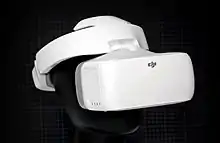
The DJI FPV series[62] are head-mounted displays designed for FPV drone flying. There are two different product lines in the FPV series, the DJI Goggles (DJI飞行眼镜) and the Digital FPV System (FPV数字图传系统). The DJI Goggles are designed to interface with DJI-branded drones, using dual LC display screens, wireless connectivity and direct photo and video capture control. In November 2017, DJI also released DJI Goggles RE ("Racing Edition"), which featured compatibility with racing quadcopters.[63] The DJI Digital FPV System is a standalone system designed for non-DJI brand or custom-built drones.[64]
RoboMaster S1
On 11 June 2019, DJI unveiled the RoboMaster S1 (机甲大师 S1), its first consumer ground drone, named after DJI's annual RoboMaster robot combat competition,[65] of which it is now an unofficial mascot. The S1 is a tank-like rover remotely controlled via Wi-Fi and an app on Microsoft Windows, Apple iOS and Google Android mobile devices. Designed to be an "advanced educational robot", the user has to assemble the S1 from loose parts out of the box and learn to program its AI functionality. Both Scratch and Python are programming languages employed by DJI along with app learning modules to teach the end user how to code.[66]
RoboMaster EP
The DJI RoboMaster EP (机甲大师 EP) was officially released on March 9, 2020, although it was first teased in a YouTube RoboMaster S1 commercial on November 25, 2019.[67] On August 8, DJI formally launched an upgraded version named RoboMaster EP Core. Intended to be a counterpart to the Engineer robot from the competition, the EP Core features a gripper and numerous infrared distance sensors that can detect between 0.1–10 m (3.9 in–32 ft 9.7 in).
The EP supports more than 20 third-party sensors and open-source hardware such as Micro Bit, Arduino and Raspberry Pi.[68]
Controversies
Privacy and security concerns
In August 2017, the United States Army published internal guidance banning the use of DJI products for security reasons, although as of 2019 other branches of the US military continue to use its products in a limited capacity.[10]
On 17 November 2017, Ars Technica reported a security breach of private customer data at DJI that was uncovered by security researcher Kevin Finisterre.[69] The company denied the existence of such a breach, and subsequently added an offline mode that allows its drones to fly without transferring data over the internet.[70] The Register reported in August 2017 that the DJI's Go app contains a framework that allows DJI to make "substantial changes" to the app without triggering a review by Apple.[71] According to Kevin Finisterre, the hot-patch mechanism would've allowed DJI to covertly update the app without first seeking user consent, a critical security flaw.[72]
In 2018, Kivu Consulting released a report commissioned by DJI that largely refuted the allegations related to DJI's mishandling of user data. However, the report confirmed that the DJI GO 4 mobile app did transfer information to Chinese servers through a crash reporting app called Bugly.[72]
In January 2020, the United States Department of the Interior announced that it would be grounding around 800 DJI drones over security concerns, which it had been using for wildlife conservation and infrastructure monitoring purposes.[73]
In a May 2020 report analyzing the data use of DJI's Mimo app, which is used to control the Osmo gimbles from a smartphone, security research company River Loop Security made several discoveries "of concern" for users and policy-makers.[74] According to the researchers, the app sends a variety of data, including sensitive personal information, through insecure means to servers located in China without user consent, raising suspicions that personal user data could be freely accessible to the Chinese authorities.[74] User information was also sent to third-party servers, "where the Terms of Use Agreement supports cooperation with the Chinese Government."[74]
In July 2020, two reports on the security of the DJI GO 4 mobile app found that it was highly obfuscated to prevent security analysis, collected user information from phones and was able to force the installation of updates or other applications.[75] The app was also found to be able to download and install arbitrary applications, although this required approval by the user.[76] Furthermore, the app restarted after being closed and continued running in the background and sending telemetry requests while the user believes it to be inactive.[76] Because of the far-reaching permissions to use the app means that servers owned by DJI or Weibo "have almost full control over the user's phone."[77] Furthermore, Google's app store was unable to do any verification of any updates pushed by DJI. No issues related to hidden updates were found on the app's iOS version.[77]
In August 2020, Synacktiv alleged that DJI's Pilot app shares many of the same issues present in DJI GO 4, which DJI denied.[78]
In November 2020, senators Chris Coons, Rick Scott, and others criticized a decision by the United States Air Force to purchase DJI drones on security grounds.[79]
In December 2020, the United States Department of Commerce added DJI to the Bureau of Industry and Security's Entity List.[80][81]
In January 2021, Trump signed an executive order mandating the removal of Chinese-made drones from U.S. government fleets.[82]
Incidents involving DJI products
In January 2015, a Phantom 3 crashed into the White House's south lawn, in Washington, D.C., US.[83] DJI later set up a no-fly Geo-system according to prohibited airspace, and forced all drones to update the firmware. The new system will forbid flights getting closer or take off in restricted zones based on its GPS location.[84]
In the 2015 Tokyo drone incident, a DJI Phantom 2 drone carrying radioactive material was landed on the Prime Minister's Official Residence. Subsequently, the National Diet passed a law restricting drone flights near government buildings and nuclear sites.[85]
In 2016, ISIS used DJI drones as exploding devices in Iraq.[86][87] DJI later created a broad no-fly zone over nearly all of Iraq and Syria.[9] That year, a DJI drone was nearly involved in a midair collision with a Chinese fighter jet. The Chinese government subsequently insisted that DJI develop an air traffic registry to track its drones within China.[8]
On 30 March 2018, Israel Defense Forces used DJI's Matrice 600 drone to drop tear gas from above, causing injuries, panic and death during Gaza and West Bank protests.[88][89]
On 4 August 2018, two Matrice 600 drones detonated explosives near Avenida Bolívar, Caracas in an apparent attempt to assassinate Nicolás Maduro.[90]
In 2020,"Matrice 200" series drones that were used by the UK police force fell out of the sky and crashed in the rain due to technical failures.[91]
See also
- List of unmanned aerial vehicles of China
- List of Chinese companies
References
- "Drone-maker DJI to develop more industry applications - Chinadaily.com.cn". Jan 27, 2018. Retrieved Jan 30, 2018.
- "关于大疆:DJI大疆招聘". Retrieved Apr 7, 2020.
- "Company Overview of SZ DJI Technology Co., Ltd". www.bloomberg.com. Retrieved 2018-12-03.
- "10 Things You Probably Didn't Know About DJI". Uplift Drones. June 20, 2018. Archived from the original on June 20, 2018.
- Joshi, Divya. "Here are the world's largest drone companies and manufacturers to watch and stocks to invest in 2020". Business Insider. Retrieved 2020-10-09.
- "World's top drone seller made $2.7 billion". January 3, 2018.
- French, Sally (18 September 2018). "DJI MARKET SHARE: HERE'S EXACTLY HOW RAPIDLY IT HAS GROWN IN JUST A FEW YEARS". thedronegirl.com.
- Schmidt, Blake; Vance, Ashlee (25 March 2020). "DJI Won the Drone Wars, and Now It's Paying the Price". www.bloomberg.com. Retrieved 2020-04-03.
- "Drone maker DJI quietly made large chunks of Iraq, Syria no-fly zones". The Register. 2017-04-26. Retrieved 2019-11-12.
- "US Military Still Buying Chinese-Made Drones Despite Spying Concerns". VOA. Retrieved 2019-09-18.
- Colum Murphy and Olivia Geng (November 10, 2014). "Q&A: Chinese Drone Founder Explains Why Steve Jobs Is His Role Model". The Wall Street Journal. Retrieved March 2, 2015.
- "Alumni Kaleidoscope – Frank Wang".
- Mac, Ryan. "Bow To Your Billionaire Drone Overlord: Frank Wang's Quest To Put DJI Robots Into The Sky". Forbes. Retrieved 2020-04-03.
- "Up: A Chinese firm has taken the lead in a promising market". The Economist. 11 April 2015. Retrieved 19 April 2015.
- Ben Popper. "Rise of the RoboMasters".
- Schroth, Frank (31 August 2017). "DJI Wins 2017 Emmy for Technology and Engineering". DRONELIFE.
- "Drone maker Frank Wang becomes Asia's youngest tech billionaire". techwireasia.com.
- "Frank Wang". Forbes. Retrieved 2020-10-16.
- "大疆创新与新疆自治区公安厅结为警用无人机战略合作伙伴". YouUAV.com. 24 December 2017.
- "The Next Frontier of Police Surveillance Is Drones". Slate. 2018-06-07. Retrieved 2019-12-10.
- "These Police Drones are Watching You". Project On Government Oversight. 2018-09-25. Retrieved 2019-12-10.
- Berlinger, Joshua. "Chinese drone maker DJI uncovers fraud that could cost it $150 million". CNN. Retrieved 23 January 2019.
- Horwitz, Josh (22 January 2019). "China drone maker DJI says $150 million scam involved staff padding..." Reuters. Retrieved 23 January 2019.
- "DJI - The World Leader in Camera Drones/Quadcopters for Aerial Photography". DJI Official. Retrieved 2020-10-16.
- See how drones are helping fight coronavirus - CNN Video, retrieved 2020-10-16
- "DJI to Raise $1 Billion in Innovative Bidding Process - Caixin Global". www.caixinglobal.com. Retrieved 2020-10-12.
- Avery, Chen (28 July 2020). "Mainland drone giant's IPO could take flight". The Standard. Retrieved 12 October 2020.
- Team, Investment Research (2015-09-24). "DJI Reportedly Raising $500M New Round From Investors". China Money Network. Retrieved 2020-10-12.
- "Tech in Asia - Connecting Asia's startup ecosystem". www.techinasia.com. Retrieved 2020-10-09.
- "The A2 model". DJI Technology. Retrieved March 2, 2015.
- "DJI Naza-H Helicopter Gyro System w/ GPS". Helipal. Retrieved March 2, 2015.
- "The A2 model". OXM HOFFMAN 360. Retrieved March 2, 2015.
- "DJI Ronin-S". Heliguy. Heliguy. 2018-01-18. Retrieved 2019-08-30.
- "DJI Ronin-SC Announced". Heliguy. Heliguy. 2019-07-17. Retrieved 2019-08-30.
- "Flame Wheel ARF Kit". DJI Technology. Retrieved March 2, 2015.
- "FYFT M5 series blimps". DJI Technology. Retrieved March 2, 2015.
- Personal Tech (September 10, 2014). "An Eye in the Sky, Accessible to the Hobbyist: A Teardown of the Phantom 2 Vision Plus Drone from DJI". The New York Times. Retrieved March 2, 2015.
- "DJI Phantom Released". Retrieved March 2, 2015.
- "2016 DJI Phantom 3 Standard Review | New Lower Price". What Are The Best Drones?. Retrieved 2016-04-19.
- Chase Sutton. "DJI Phantom 2 Vision+ Review and Manual". DroneLifestyle. Retrieved March 2, 2015.
- "DJI Phantom 4 RTK". DJI Enterprises. Oct 15, 2018. Archived from the original on December 15, 2018. Retrieved Nov 1, 2018.
- "DJI Phantom 3 vs Phantom 2 comparison". Drones Den. June 15, 2015. Retrieved June 19, 2015.
- "Is A DJI Mavic Air 2 Without AirSense Worth Buying?". Heliguy. Heliguy. Retrieved 16 June 2020.
- "Spreading-Wings s1000 Plus". DJI Technology. Retrieved March 2, 2015.
- Murison, Malek. "DJI Has Decided That The Inspire 2 is Too Fast". dron life. Retrieved 8 May 2017.
- "DJI Inspire 1 & Inspire 1 Pro Specifications". HoverShotz Aerial Drone Photography, Video and Inspections Cumbria. 2017-01-16. Retrieved 2017-05-16.
- "Drone Best". Archived from the original on 2017-08-31. Retrieved 2017-08-30.
- "DJI Matrice 200 Series". Heliguy. Retrieved 12 September 2017.
- Matrice 100 release history DJI
- "MATRICE 100: an advanced quadcopter for developers". My Drone Lab. Retrieved 20 March 2018.
- "DJI Spark is a Selfie Drone for the Masses". News Ledge. 2017-05-24. Retrieved 2017-05-30.
- People are complaining that their new DJI Spark drones are falling out of the sky — Quartz
- "DJI Spark Firmware Update Enhances Flight Safety". DJI Official. Archived from the original on 2019-12-28. Retrieved 2017-09-30.
- "DJI Osmo Pocket – 3-Axis Stabilized Handheld Camera – DJI". DJI Official. Archived from the original on 2019-07-01. Retrieved 2018-11-28.
- "Osmo Action – Unleash Your Other Side – DJI". DJI Official. Archived from the original on 2019-08-11. Retrieved 2019-05-16.
- Goldman, Joshua. "DJI Osmo Action cam has two big features your GoPro doesn't". CNET. Retrieved 2019-05-16.
- Chavers·GearPhotography·May 16, Marcus; 2019 (2019-05-16). "How Does the DJI Osmo Action Stack Up Against the GoPro Hero7?". News Ledge. Retrieved 2019-05-16.CS1 maint: numeric names: authors list (link)
- "Osmo Mobile Specs". DJI. Archived from the original on 2016-09-10.
- "DJI Osmo Mobile 2 – Smartphone Gimbal – DJI". DJI Official. Archived from the original on 2019-07-24. Retrieved 2018-09-10.
- "Shutter Release: How to Choose the Best Vlogging Cameras of 2018". News Ledge. 2017-06-08. Retrieved 2018-09-10.
- "Osmo Mobile 3 - Foldable Mobile Gimbal-DJI". DJI Official. Archived from the original on 2019-12-26. Retrieved 2019-08-16.
- "DJI Goggles". DJI. Archived from the original on 2017-04-27.
- "DJI Racing Edition Goggles". Drone Addicts.
- "DJI Digital FPV System". Archived from the original on 2019-12-19. Retrieved 2019-10-16.
- "The RoboMaster S1 – Intelligent Educational Robot – DJI". DJI Official. Archived from the original on 2019-09-28. Retrieved 2019-06-23.
- O'Kane, Sean (2019-06-11). "DJI's newest drone is a $499 tank meant to teach kids how to code". The Verge. Retrieved 2019-06-23.
- DJI (2019-11-25). DJI RoboMaster S1 - Creativity is a Gift. YouTube. Retrieved 2020-03-10.
- Kesteloo, Haye (2020-03-09). "DJI releases RoboMaster EP on March 9th as predicted". DroneDJ. Retrieved 2020-03-10.
- "DJI left private keys for SSL, cloud storage in public view and exposed customers".
- "DJI Launches Privacy Mode For Drone Operators To Fly Without Internet Data Transfer". Archived from the original on 2019-09-24. Retrieved 2018-02-02.
- "Drone-maker DJI's Go app contains naughty Javascript hot-patching framework". www.theregister.com. Retrieved 2020-10-09.
- "DJI Releases Security Findings It Hopes Will Quash 'Chinese Spying' Fears". Gizmodo. Retrieved 2020-10-09.
- Friedman, Lisa; McCabe, David (2020-01-29). "Interior Dept. Grounds Its Drones Over Chinese Spying Fears". The New York Times. ISSN 0362-4331. Retrieved 2020-10-12.
- "Analyzing Data Use by the DJI Mimo App". www.riverloopsecurity.com. Retrieved 2020-10-14.
- Mozur, Paul; Barnes, Julian E.; Krolik, Aaron (2020-07-23). "Popular Chinese-Made Drone Is Found to Have Security Weakness". Retrieved 2020-10-15.
- "DJI Privacy Analysis Validation". July 23, 2020. Retrieved 2020-10-15.
- "DJI Android GO 4 application security analysis | Synacktiv". www.synacktiv.com. Retrieved 2020-10-15.
- "DJI Pilot app shares same security flaws as DJI Go 4, says Synacktiv". DroneXL.co. 2020-08-04. Retrieved 2020-10-16.
- Forrest, Brett; Lubold, Gordon (2020-11-02). "Air Force Purchase of Chinese Drones Spurs Security Concerns". The Wall Street Journal. ISSN 0099-9660. Retrieved 2020-11-06.
- Alper, Alexandra; Shepardson, David; Pamuk, Humeyra (2020-12-18). "U.S. blacklists dozens of Chinese firms including SMIC, DJI". Reuters. Retrieved 2020-12-19.
- "Addition of Entities to the Entity List, Revision of Entry on the Entity List, and Removal of Entities From the Entity List". US Federal Register. Retrieved 2020-12-22.
- "Trump orders assessment of security risks of Chinese made drones in U.S. govt fleet". Reuters. 2021-01-18. Retrieved 2021-01-19.
- "Drone maker DJI bans Washington flights after White House crash". BBC. Retrieved 2018-01-24.
- "FLY SAFEGEO-ZONE MAP". DJI. Archived from the original on 2018-01-24. Retrieved 2018-01-24.
- "Arrest over Japan radioactive drone". BBC News. 2015-04-25. Retrieved 2020-09-27.
- "Isis use of hobby drones as weapons tests Chinese makers". Financial Times. 2017-12-10. Retrieved 2019-11-12.
- "Pentagon Confronts a New Threat From ISIS: Exploding Drones". The New York Times. 2016-10-12. Retrieved 2019-11-12.
- "Waves of Gazans vs. Israeli Tear Gas and Bullets: Deadliest Mayhem in Years". The New York Times. 2018-05-14. Retrieved 2019-11-28.
- "First ISIS, then Iraq, now Israel: IDF Use of Commercial Drones". Bellingcat. 2018-06-18. Retrieved 2019-11-28.
- Joe Parkin Daniels (5 August 2018). "Venezuela's Nicolás Maduro survives apparent assassination attempt". The Guardian. Retrieved 5 August 2018.
- Amy Woodyatt. "Police drones are falling from the sky when it rains, report finds". CNN. Retrieved 2020-10-04.
External links
 Media related to DJI (company) at Wikimedia Commons
Media related to DJI (company) at Wikimedia Commons
